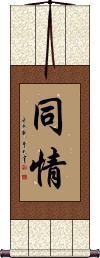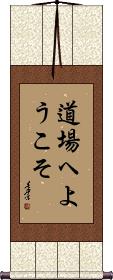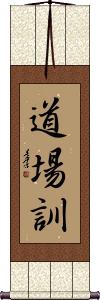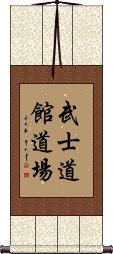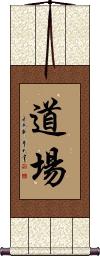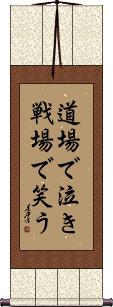Many custom options...
And formats...

Dojo in Chinese / Japanese...
Buy a Dojo calligraphy wall scroll here!
Personalize your custom “Dojo” project by clicking the button next to your favorite “Dojo” title below...
Compassion
These two characters mean compassion and sympathy in Chinese, Japanese, and Korean, which makes this word universal.
Compassion is caring and understanding someone is hurt or troubled (even if you don't know them). It is wanting to help, even if all you can do is listen and say kind words. You forgive mistakes. You are a friend when someone needs a friend.
Welcome to the Dojo
Dojo Kun
Aces Dojo
Bushidokan Dojo
Tenshin Dojo
Shoshin Karate-do Dojo
Shoshin Karate Dojo
Dojo / Martial Arts Studio
道場 is the Japanese term for a room or hall in which martial arts are taught.
道場 is often spelled “dojo” which has become a word in the English lexicon. However, the true Romaji is doujou or dōjō.
Please note: The Chinese definition of these characters is quite different. In Chinese, this is a place where Buddhist or Taoist mass is held. It could also be a place where spiritual or psychic events are performed.
Chushin Aikido Dojo
Five Element Dojo
This is the title “5 Element Dojo” in Japanese Kanji.
Sometimes, the five elements are expressed in Japanese as 五大 (Godai) (earth, water, fire, wind, void) instead of the Chinese/Traditional 五行 (Gogyo) (wood, fire, water, earth, metal), so you might want 五大道場 instead. Let me know when ordering if that is the case.
Cry in the Dojo - Laugh on the Battlefield
道場で泣き戦場で笑う is a Japanese phrase that means “Cry in the dojo, laugh on the battlefield.”
You'll see this phrase in a lot of dojos as a kind of philosophical joke.
Note: Because this selection contains some special Japanese Hiragana characters, it should be written by a Japanese calligrapher.
See Also: The More We Sweat in Training the Less We Bleed in Battle
The following table may be helpful for those studying Chinese or Japanese...
| Title | Characters | Romaji (Romanized Japanese) | Various forms of Romanized Chinese | |
| Compassion | 同情 | dou jou / doujou / do jo | tóng qíng tong2 qing2 tong qing tongqing | t`ung ch`ing tungching tung ching |
| Welcome to the Dojo | 道場へようこそ | dou jou e youkoso doujoueyoukoso do jo e yokoso | ||
| Dojo Kun | 道場訓 道場训 | dou jou kun doujoukun do jo kun | ||
| Aces Dojo | エースド道場 | eesu doo joo eesudoojoo esu do jo | ||
| Bushidokan Dojo | 武士道館道場 武士道馆道场 | bu shi dou kan dou jou bushidoukandoujou bu shi do kan do jo | wǔ shì dào guǎn dào chǎng wu3 shi4 dao4 guan3 dao4 chang3 wu shi dao guan dao chang wushidaoguandaochang | wu shih tao kuan tao ch`ang wushihtaokuantaochang wu shih tao kuan tao chang |
| Tenshin Dojo | 天心道場 | ten shin dou jou tenshindoujou ten shin do jo | tiān xīn dào chǎng tian1 xin1 dao4 chang3 tian xin dao chang tianxindaochang | t`ien hsin tao ch`ang tienhsintaochang tien hsin tao chang |
| Shoshin Karate-do Dojo | 正心空手道道場 | shou shin kara te dou dou jou shoushinkaratedoudoujou sho shin kara te do do jo | ||
| Shoshin Karate Dojo | 正心空手道場 | shou shin kara te dou jou shoushinkaratedoujou sho shin kara te do jo | ||
| Dojo Martial Arts Studio | 道場 道场 | dou jou / doujou / do jo | dào cháng dao4 chang2 dao chang daochang | tao ch`ang taochang tao chang |
| Chushin Aikido Dojo | 中心合気道道場 | chuu shin ai ki dou dou jou chuushinaikidoudoujou chu shin ai ki do do jo | ||
| Five Element Dojo | 五行道場 | go gyou dou jou gogyoudoujou go gyo do jo | ||
| Cry in the Dojo - Laugh on the Battlefield | 道場で泣き戦場で笑う | doujou de naki senjou de warau dojo de naki senjo de warau | ||
| In some entries above you will see that characters have different versions above and below a line. In these cases, the characters above the line are Traditional Chinese, while the ones below are Simplified Chinese. | ||||
Successful Chinese Character and Japanese Kanji calligraphy searches within the last few hours...
